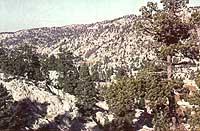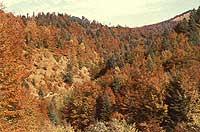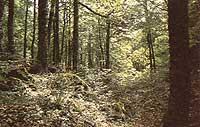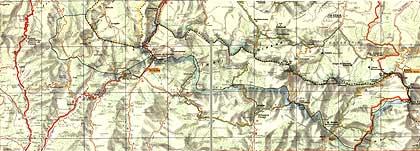Pyrenean natural park in Navarre

The example of the US, to a greater or lesser extent, has been imitated by other countries, although some have done so for a long time and others have done so recently.
In Spain, with the National Parks Law of 1916, the first in Europe, the creation of a network of protected spaces began. The first levels of this network are the natural parks of Covadonga and Ordesa. Much later, in 1975, the Law of Protected Natural Spaces was promulgated. This law tries to complete it with different legal figures of protected spaces, such as the National Park, the Total Reserve, the Natural Park and the Natural Park. This last law was used in a very restricted way for many years until the competences on the protection of nature were transferred to the Autonomous Communities.
In France, the development of the protection of natural resources began later. The law of National Parks dates from 1960 and one of its fruits was the National Park of the Western Pyrenees, declared in 1967. The Western limit of this park is 3.5 km from the Eastern limit of Navarre, reaching the front of it. Subsequently the large number of Regional Natural Parks (21 today) was recognized, among them the closest for us is that of Landa.
As the basic structure of the protected media was established according to the criteria of the centralist states, at the beginning of the 80's we find the paradox that the Basque Country had no environment of strong legal protection.
Natural value of the Navarrese Pyrenees

The absence of a legally protected medium does not mean that the territorial limits of scarce traces of human activity have not been reached, or that, for various reasons, nature has not been maintained in good conditions, much less that there are no relevant values. Any attentive observer knows these corners of our geography. Undoubtedly, the Pyrenees Navarro occupies a privileged place between this natural space and the valleys of Aezkoa, Salazar and Roncal enjoy natural values that deserve special protection and treatment.
In the highest peaks of the Roncal is the only territory corresponding to the alpine soil of the Basque Country, with its characteristic flora and fauna species.
One of the most remarkable elements of the firm subalpine is the black pine ( Pinus uncinata ), which lives in singular places of Larrea. In addition, this place has another peculiarity, since it is a karst zone with an underground hydrological network of great development and with the highest level of the world.
The white fir (Albies alba) here has the western border of the world (in the valley of Aezkoa) and forms mixed forests with beech (Fagus sylvatica). Irati, which houses the unspoilt natural areas of Lizardoia of Mount Question Salazar and Aztaparreta of Roncalés Belagoa, are very famous.
Pine pinewoods ( Pinus sylvestris ) divide the forest surface with fattened fir trees, which together with grasses, rocks and crops form a mosaic.

In this landscape you move fauna of interest. The most significant and remarkable species of this fauna are: Brown bear ( Ursus arcoto ), sarrio ( Rupicapra rupi-capra ), deer ( Cervus elaphus ), deer ( Capreolus capreolus ), boar ( Sus scrofa ), armiño ( Mustela erminea ), pyrenaic flax ( Galemys pyrenaicus ), lagtus ( Galemys )
These natural elements are integrated into a landscape in which there is no lack of evidence of human intervention. But these vestiges, some very ancient, attribute to the whole the characteristics of the harmonious integrity of natural and artificial elements and not only of the natural ecosystem.
The evidence of these human interventions can be found in the remains of prehistoric megalithic monuments, in the dolmens of Belagoa and Abodiko, in the Cromlechs of Azpegi, in the Roman tower of Urkulu, in the popular architecture of the ancient Bordas and in later interventions as the refuge of Belagua.

However, it should be mentioned that the good state of conservation of the Navarrese Pyrenees does not correspond to the scientific will of protection. On the contrary, to the extent that the steep distances and topography have been an obstacle to the exploitation of resources, the climatic conditions have led to the degraded areas having been easily regenerated.
It has had an official recognition, in addition to the popularity of popular adherence to the natural interest of this territory. If the National Inventory of Remarkable Landscapes published by ICONA in 1975 mentioned 10 areas in Navarre, 4 of them belonged to the Pyrenees: Hayedos, Batidos 3.000 Ha and Pastos 3.000 Ha, areas of Aezkoa 1.000 Ha, plains of Auritz and Roncesvalles 500 Ha. In the Open Inventory of Natural Spaces of Special Protection of 1978 of the General Directorate of ICONA and Urbanism, 3 of the 7 zones invented in Navarre belonged to the Pyrenean area: Larra 3.400 Ha., Hayedo de Irati (including the Aezkoa Mountains) 13.448 Ha., Quinta Real 5.970 Ha. But this recognition had no legal consequences.
Idea of the project and resources for the creation of the Park
The idea of creating a protected environment in the Navarrese Pyrenees for the first time appears in 1973 in the Belagua Environment Planning commissioned by the Diputación de Navarra to the cities of Francisco Intza and Fernando Redón. The executors of the Plan replaced the initial layout of a large ski trail, another lower one and the Natural Park project that would continue to the west towards the high valleys of Salazar and Aezkoa.

"Navarra. The "Ecological and landscape guide" outlines what within the Pirenaico Natural Park could be the network of protected spaces in Navarre.
Study of the Physical Medium of Navarre carried out in 1985 by order of the Institute of Territorial Studies. The report "Rules of protection and use of the territory" again shows the Natural Park Pirenaico as main part of the network of protected spaces.
The path of Idea continues and its acceptance is increasingly widespread.
As a result of the transfer of powers of the State to the Foral Community of Navarre in matters of conservation of nature, two important laws have been approved, which can facilitate the creation of the Pirenaico Natural Park.
In the Law on Regional Urban Standards for the Protection and Use of the Territory of April 1987, Aztaparreta Total Reserve (174 Has), Ukerdi (309 Has in the heart of Larrea) and Lizardoia (64 Has), and Larra Nature Reserve (2,353 Has) and Mendilz (119 Has) are declared. In addition, the figure of the Natural Park is consolidated as a form of management of the Territory. The Ordinance of the Territory Law of November 1986 defines the regulations of the Physical Environment Planning, the most appropriate method to reach the declaration of the Natural Park.

The Pirenaico Natural Park in Navarre was published in July 1986 by the Department of Territorial Planning of the Government of Navarre. I. The book "Larra-Belagoa" is proof of the real will of the Foral Government to create this Park.
The future of the Pyrenees Navarro Natural Park
Although the concrete limitations of this future park must be fixed by the existing studies, at first it seems that from Ibañeta to the Table of the Three Kings, with the western limit of the villages of Orbaizta, Iriberri, Otsagi, Uztarroze and Isaba. It is not possible to ignore the idea that from the west to Quinta Real and from the south will welcome some of the villages of head of valley.
It seems that the figure of the Natural Park is the most suitable for this territory, since it would not be logical that the National Park, according to the general criterion, out of it all the uses of resources.
The main objectives of the park would be very briefly the following:
- The protection of nature, and the first step for it, would be the recognition of reserves.
- Promotion of eco-management, that is, productive activities compatible with conservation, such as forestry, livestock and agriculture.
- Improve relationships between man and nature, fostering camping, sport, excursions, animal and vegetable observation, guided tours, etc.
- Encourage research, both of nature and of agricultural exploitation.
To achieve these objectives, after the legal declaration of the Natural Park, a team of directors must be organized in which the administration, the scientists, the sponsors and, of course, the neighbors of the affected peoples are represented.
In a second phase it would be more interesting to include this Navarro Park in a Pyrenees on regional divisions and state borders, constituting a large Park of European dimensions and projection.
(Translated into Basque by Mariaje Jauregi)
Buletina
Bidali zure helbide elektronikoa eta jaso asteroko buletina zure sarrera-ontzian












